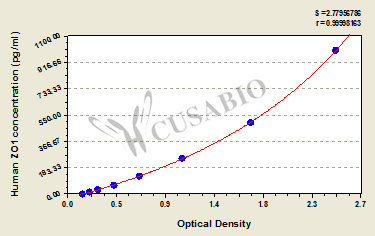The Human tight junction protein 1 (ZO-1) ELISA kit is a sandwich immunoassay specifically designed and validated for the quantitative detection of ZO-1 in the serum, plasma, cell culture supernates, or cell lysates. It is not intended for diagnostic use. This assay kit was designed and optimized for Tags & Cell Markers research use in humans. The kit has undergone rigorous quality control in multiple parameters, including sensitivity, specificity, precision, linearity, recovery, and inter-batch difference. Refer to the product instructions for more details. This assay employs the quantitative sandwich enzyme immunoassay technique, in which ZO-1 in the samples or standards are sandwiched between pre-coated ZO-1 antibody and Biotin-conjugated antibody specific for ZO-1. HRP-avidin is then added to the wells. Following a wash to remove any unbound reagent, the TMB substrate solution is added to the wells and color develops in proportion to the amount of ZO-1 bound in the initial step. The color development is stopped upon adding the stop solution, and the intensity of the color is measured at 450 nm via a microplate reader. The levels of ZO-1 in the samples are determined by comparing the O.D. (optical density) of the samples to the standard curve.
ZO-1, also called TJP1, is a tight junction (TJ) phosphoprotein acting as a scaffold protein that cross-links and anchors tight junction strand proteins to the actin cytoskeleton. ZO-1 organizes and regulates the structure of tight junctions through direct interactions with transmembrane factors including claudin (CLDN), occludin (OCLN), and junction adhesion molecule A (JAM-A). Besides, ZO-1 shuttles between the nucleus and plasma membrane modulate paracellular permeability and participate in the regulation of gene expression. ZO-1 can also bind to ZONAB through its Src homology 3 (SH3) domain. ZONAB is involved in the control of epithelial cell proliferation. ZO1 was down-regulated in many cancers and decreased ZO1 expression may be closely related to patient prognosis.






